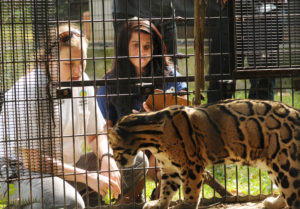Imagine getting up close and personal with the world’s most endangered species – and then having the chance to save them.

Thanks to a partnership with the Smithsonian-Mason School of Conservation (SMSC), Mary Washington students will soon have that experience. They’ll spend a semester working directly with these animals and learning from Smithsonian scientists and George Mason University professors at the Smithsonian Conservation Biology Institute, nestled at the foot of the Blue Ridge Mountains. The agreement comes just as UMW’s biology department introduces a new major in conservation biology.
“We’ve always had a cadre of students who are passionate about conservation and sustainability,” said Professor Alan Griffith, who teaches conservation biology at Mary Washington. He and his colleagues recently toured SMSC’s Front Royal, Virginia campus and were impressed with the program and its quality of instruction.
For the last several years, Mason has wanted to partner with UMW – it has similar agreements with smaller schools like Bridgewater and Sweet Briar colleges – but a meeting this spring between the two schools solidified the decision to move forward.
“Because of its strong emphasis on the liberal arts, Mary Washington is the type of environment that produces students that are perfect for our program,” said Cody Edwards, SMSC’s executive director and an associate provost at Mason.
Starting in fall 2020, SMSC will make six of its 40 seats available for Mary Washington students. Students will choose from two cohorts exploring such topics as biodiversity, animal behavior and reproduction, ecology, genetics, migration and conservation sustainability. Loosely structured, the interactive, hands-on courses give students the chance to delve into real-life field research. The 16 course credits they’ll earn through the program will transfer to UMW.
Students will reside in a living and learning community located on 3,200 acres of forest, grasslands and pasture on the Shenandoah River. The campus’s three buildings – a residence hall, dining commons and an academic center with state-of-the-art classrooms and research labs – are all designed with a focus on environmental sustainability and “green” construction.
While the National Zoo in Washington D.C., is the public face of the Smithsonian, the research facility houses a wide range of critically endangered mammals, birds, reptiles and amphibians, including clouded leopards, red pandas and Mongolian wild horses.
Once populations dwindle, in-breeding makes animals more susceptible to genetic disorders, which SMSC students are actively researching. After news circulated of a clouded leopard cub being born through in-vitro fertilization, a researcher in the field was amazed to learn it happened at his facility, Edwards said, as well as that undergraduates were involved in the procedure.
“This will be a unique and exciting experience for UMW students,” said Griffith, explaining that they will have the rare opportunity to work closely with endangered species and the plants in their habitat.
Having the chance to “study away” is an invaluable experience, as science majors often miss out on study abroad opportunities due to their course work, which must be taken in sequence. Plus, SMSC students work alongside leading scientists and policy practitioners, and get private audiences with world-renowned conservationists the likes of Jane Goodall.
The revered British primatologist, who rarely makes public appearances, will give an exclusive talk to undergraduates at the Smithsonian Conservation Biology Institute this fall, Edwards said.
And with just one office for internships for the entire Smithsonian Institution and hundreds of thousands of applicants each year, “this program puts students at the front of the line,” Edwards added. “When you have the Smithsonian on your resume, it opens a lot of doors.”
College of Arts and Sciences Dean Keith Mellinger thinks these types of partnerships between Mary Washington and schools like Mason are a win for everyone.
“We have a reputation around the commonwealth for educating students at an exceptional level and preparing them for graduate schools, research and careers,” Mellinger said. “By leveraging the expertise of our sister institutions around the state, we’re creating pathways for UMW students to ignite their passions and explore their interests.”




